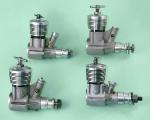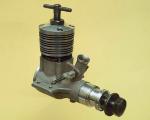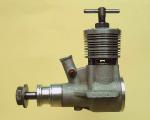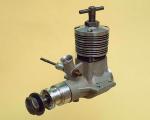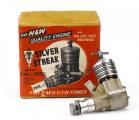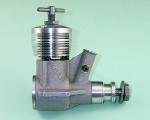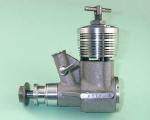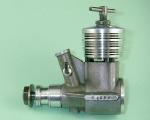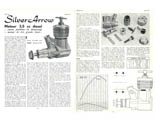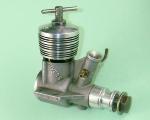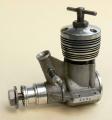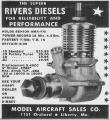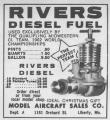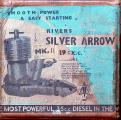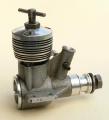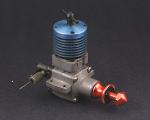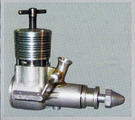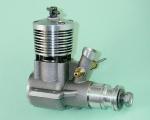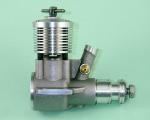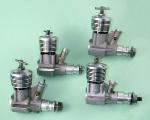Feltham Fliers:
The Rivers Engines
by Adrian Duncan
2012-05
Revised:
2012-10
Part II
-
 Background
Background -
 Design Considerations
Design Considerations -
 The Rivers Silver Streak Mk I
The Rivers Silver Streak Mk I -
 The Rivers Silver Streak Mk I On Test
The Rivers Silver Streak Mk I On Test -
 Early Competition Success
Early Competition Success -
 The Mk I Rivers Silver Arrow
The Mk I Rivers Silver Arrow -
 The Mk I Silver Arrow On Test
The Mk I Silver Arrow On Test -
 Upgraded Versions of the Silver Streak and Silver Arrow
Upgraded Versions of the Silver Streak and Silver Arrow -
 The Mk II Versions of the Rivers Engines
The Mk II Versions of the Rivers Engines -
 A Rare Variant—The Rivers Silver Arrow 19
A Rare Variant—The Rivers Silver Arrow 19 -
 The Rivers That Never Was—The Silver Bullet
The Rivers That Never Was—The Silver Bullet -
 Further Contest Successes
Further Contest Successes -
 A Belated Response—The Silver Streak Mk III
A Belated Response—The Silver Streak Mk III -
 The End of the Road
The End of the Road -
 Production Figures
Production Figures -
 A Latter-day Clone—The CS Rivers
A Latter-day Clone—The CS Rivers -
 Conclusion
Conclusion
The Mk II Versions of the Rivers Engines
Now that we've dealt as best we can with the Silver Arrow identification issue, we can proceed with our main story. Beginning with the Silver Streak, the revised Mk II model featured the beefed-up crankshaft first mentioned by Peter Chinn in his April 1960 article to which reference was made earlier. As recorded by Ron Warring in his July 1960 test of the Silver Arrow, the diameter of the roller bearing journals was increased from 0.350" to 0.406", with the number of rollers being increased from seven to eight, still at 1.5mm diameter. The increase in the roller bearing journal diameter permitted a concurrent increase in the diameter of the central gas passage in the shaft from 0.203" to 0.256", a wall thickness of 0.075" being maintained.
The diameter of the central plain bearing section which incorporated the induction port was also increased from its former 0.4682" to a truly whopping 0.524" (13.31mm). Along with this went some minor changes to the induction timing to match the engine's theoretically improved breathing capacity. The prop mounting system was changed from the original prop nut design to the prop bolt arrangement mentioned by Warring.
The crankcase was also modified, featuring an increased diameter with a consequent increase in crankcase volume. This measure appears to have been aimed at improving the engine's fuel consumption for team racing. The crankcase sported a revised intake along the lines of the unit featured on the companion Silver Arrow, being far taller than that used on the original Silver Streak and lacking the former bell-mouth. As on the Arrow, the spraybar was now aligned at right angles to the engine's axis so that the needle could be oriented either to left or right of the engine.
The final change to the crankcase was the inclusion of an integrally-cast blind spigot beneath the main bearing at the intake location. This could be drilled and tapped to allow for the fitting of a nipple to take timed crankcase pressure to a pressure feed fuel system.
Bore and stroke remained unchanged, but a slightly longer piston skirt was used together with a longer con-rod. Cylinder port timing was slightly altered as well to harmonize with these new dimensions. In all other important respects, the engine was essentially unchanged from its predecessor. However, the various changes had pushed the weight up from 5.9 oz. (168gm) to an even more porky 6.8 oz (192 gm)—very hefty indeed for a 2.5cc diesel. The larger shaft and bearings doubtless accounted for most of this increase.
The engines were packaged in sturdy cardboard boxes with a label having a red-and-white background. The boxes appear to be the same ones used for the Mk I engines, since the unit illustrated on the label continued to be a Mk I model. A Mk II sticker was added to identify the contents. The boxes also bore a second sticker which covered the former Hounslow address, giving instead the company's new trading location on Faggs Road in Feltham.
A works tuned version of the Silver Streak Mk II continued to be offered, featuring a further enlargement of the internal gas passage in the crankshaft from 0.256" to 0.280" at the cost of a decrease in wall thickness at the journal to only 0.063" This however was still greater than the 0.055" wall thickness featured in the tuned version of the Mk I Silver Streak with its 0.240" dia. central gas passage. Moreover, the slightly increased wall thickness extended around a greater circumferential length of shaft, providing substantially more metal to resist operational stresses.
Along with this went a considerable amount of individual reworking, much of it carried out by hand. The cost of this tuning work was an additional �2 10s 0d (�2.50) over the price of a standard example.
A Ron Warring test of the Mk II Silver Streak appeared in the January 1961 issue of Aeromodeller. Warring described the changes which had led to the creation of the revised model, also commenting in some detail on the works tuned version, an example of which he also had available for test. His overall comment was that the Mk II version of the engine exhibited "...a definite increase in performance at the top end of the speed range".
Warring's published test figures bore out this assessment. The standard version of the Mk II Silver Streak was found to deliver 0.296 BHP @ 16,000 rpm, an increase of some 7-1/2% over Warring's figure for the previous model. Spot testing of the tuned model revealed an even more impressive improvement—indications were that this version produced some 0.34 BHP @ 16,500 rpm, an increase of over 20% on the original model and over 13% compared with the standard Mk II model.
Based upon these figures, it was evident that the tuned Mk II Rivers Silver Streak was now one of the highest-performing 2.5cc diesels of its day. However, the performance of the standard version still lagged well behind that of a number of its contemporary rivals. The recently-introduced ETA 15D Mk I had been tested in December of 1960 and found to produce 0.345 BHP @ 16,600 rpm—about the same as the tuned Mk II Rivers Silver Streak and well up on the standard Rivers 2.5cc model. The February 1961 test of the unpretentious and relatively inexpensive PAW 249 Mk III yielded figures of 0.318 BHP @ 15,000 rpm, while the March 1961 test of the Enya 15D Mk II reported an output of 0.332 BHP @ 15,000 rpm.
All of these competing models outperformed the standard Rivers Silver Streak Mk II, and did so at a significantly lower cost. The tuned Silver Streak Mk II was a match for any of them, but its overall cost of �8 15s 8d (�8.78) was well above that of any of its competitors. This did not bode well for the long-term future of the Rivers range.
It's extremely interesting to note that Peter Chinn never published a test of the Mk II Silver Streak. Chinn was clearly well-informed regarding the design details of the new variant given his coverage in his previously-mentioned articles of April and June 1960. This being the case, it's inconceivable that he would not have undertaken a direct evaluation of the new model. Chinn was well known for his reluctance to openly report unfavourably on new models from British manufacturers, generally confining himself to damning them with faint praise when he commented upon them at all! It seems likely that he had tested the new model privately and found that he would be unable to report a level of performance comparable to other less costly competitors. Rather than do this, he seems to have chosen to say nothing.
Former Hayes combat ace Robin Greenaway still has his tuned example of the Mk. II Silver Streak. Like most of the Rivers engines used by the Hayes club, this unit was supplied to Robin direct from the factory. It is numbered RWT 2, which conforms to no established Rivers serial number sequence. The best guess that the Hayes boys can come up with is that RWT stands either for "Rivers Works Tuned" or "Rivers Works Team", the latter possibility being due to the fact that the Hayes club members were the de facto Rivers works team at the time, hence their direct access to hand-picked works-tuned engines.
Turning now to the Mk IIa Silver Arrow (as I have chose to call it), we saw earlier that the major change which resulted in this model stemmed from a series of crankshaft failures in what I will refer to as the Mk I Silver Arrow. Although the public position taken on this issue was that it was down to a heat treatment fault in a specific batch of shafts, it's clear that the manufacturers themselves were not convinced. As noted by Chinn in his April 1960 article, the remedy was to re-design the shaft.
The resulting model was externally little changed from its predecessor apart from the use of a prop bolt or spinner bolt in place of the former threaded extension and nut system. However, the engine was significantly altered internally, now featuring the beefed-up 8-roller shaft described earlier. The same crankcase casting was used, merely being bored out some 60 thou oversize to accommodate the slightly larger main bearing sleeve. There was plenty of metal to accommodate this change.
Apart from the revised shaft, a few detail differences were also apparent. The engines were now supplied with a steel hexagonal nut for the purpose of locking the compression setting. While this was very effective, it had the disadvantage of requiring the use of a spanner for tightening. A locking lever would have been more practical. Another minor change was the omission of the tapped spigot in the backplate—presumably the accessory air-bleed throttle had not proved to be a great success.
The early examples of the Silver Arrow Mk IIa featured the same needle valve design as the earlier engines, with an internally-threaded thimble being tensioned by a coil spring. Engine number B874 exemplifies this type. However, by the time engine number B1046 came off the line only 172 units later, the design had been changed considerably. The engine now featured an externally threaded needle in conjunction with an internally-threaded spraybar. The thimble was now split, bearing upon the unthreaded external diameter of the spraybar and giving a very smooth yet positive action when correctly adjusted. No spring was employed in this design, although many owners seem to have added a spring regardless. Presumably this re-design was intended to make mixture corrections at higher speeds less sensitive due to the far finer pitch of the smaller thread.
The increased mass of the beefed-up shaft naturally had an effect on the engine's weight. The revised model weighed in at an extremely hefty 7.45 oz. (211 gm), some 9 gm more than the already-heavy Mk I version. At this time, competitors were just beginning to appreciate the critical importance of low wing loadings in the control-line combat models for which the Silver Arrow was primarily intended, so this was not a positive attribute of the engine. Even if the soon-to-be-enacted SMAE rule change banning 3.5 cc motors had not come into effect, it's likely that the weight factor alone would soon have caused modellers to look elsewhere for their combat powerplants.
Like the Silver Streaks, the Silver Arrows were packaged in sturdy cardboard boxes, albeit with a label having a blue-and-white background to allow easy identification of the model. Again, the boxes appear to be the same ones used for the Mk I engines, since the image on the label was unquestionably a Mk I model as tested by Peter Chinn. As with the upgraded Silver Streak, the boxes bore a Mk II sticker to identify the contents as well as featuring a second sticker which bore the company's new trading address on Faggs Road in Feltham and concealed the former Hounslow address which still appeared on the label beneath.
A further change which appeared between engine numbers B1201 and B1224 was the addition of a pressure tapping point underneath the main bearing, exactly as used on the Silver Streak Mk II. This resulted in our third variant discussed earlier, the Type 3 Silver Arrow which I have chosen to refer to as the Mk IIb. As previously noted, I am well aware that some Rivers enthusiasts consider this to be the only true Silver Arrow Mk II despite the box labels and the fact that the Mk IIa and Mk IIb variants were exactly the same engine apart from the pressure tapping point. I leave it to readers to make up their own minds on this matter—we all have a right to our own opinions!
it's perhaps an indication of decreasing interest in the Rivers 3.5cc models that neither Peter Chinn nor Ron Warring ever got around to testing the revised design despite the fact that the use of the larger 8-roller shaft with its enlarged gas passages might logically be expected to improve performance substantially. However, it's perhaps more likely that the manufacturers never sent test examples to Chinn or Warring simply because all that would really have accomplished was to create yet another opportunity for the modelling public to be reminded of the earlier crankshaft failures!
However, the Mk IIb Silver Arrow was tested! Brian Cox was able to confirm that engine number B1224 was sent by the manufacturers to "Model Avia" magazine in Brussels, Belgium, to be tested by the late Pierre Delfeld. Thanks to Brian for pointing out this connection. Thanks also to the kindness of reader George Blair who provided with a scan of Pierre's French-language report dated August 1961, of which I did a rough translation. Pierre was very taken with the engine, praising both its design and quality of manufacture. He found starting and running qualities to be as outstanding as his English colleagues had done previously. Overall, he described the engine as being "....a motor of the very highest class...".
Pierre Delfeld found an output of 0.40CV (Cheval Vapeur, equivalent to 0.395 BHP) @ 14,900 rpm, matching Chinn's figure for the Mk. I exactly, albeit at somewhat lower revs. The image provided with his test clearly proves that his sample had the larger 8-roller shaft, although for some unexplained reason his text only mentioned seven rollers. It seems that the larger shaft had not resulted in any improvement in performance—a mildly surprising finding, although admittedly from only a single example.
That said, the figure obtained by Pierre Delfeld was near enough to 0.40 BHP at pretty close to 15,000 rpm. Moreover, the makers claimed that output had been improved to over 0.400 BHP at between 15,000 and 16,000 rpm. It's a pity that this was never substantiated through an independent test in a British publication. However the makers' past claims had all been very consistent with published independent test figures, so there seems to be no reason to doubt this claim, especially when one considers the published numbers for the less developed Mk I version of the Silver Arrow with its smaller 7-roller shaft. There's little question that the Silver Arrow continued to be the world's most powerful 3.5cc diesel.
This impression was later underscored by the publication of Ron Warring's test of the Oliver Tiger Major in the April 1964 issue of Aeromodeller. The Ollie was found to produce 0.386 BHP @ 13,200 rpm. Clearly the Oliver produced more torque but could not match the then four-year old Rivers design at the top end.
Actual user impressions bore this out. Many modellers (myself among them) considered the Silver Arrow to be superior to the Oliver Tiger Major in performance terms. Sadly, by the time the Tiger Major appeared, the Rivers range was history.
Overall, the Silver Arrow Mk II was a remarkable product and a great credit to its designers and manufacturers. It was undoubtedly the crowning achievement of the Rivers model engine manufacturing venture.
A Rare Variant—The Rivers Silver Arrow 19
To open up the possibility of the engine being used in American events for which a 0.200 cuin (3.277cc) limit applied, a number of examples of the upgraded version of the engine just described were made to that displacement, using the same case as the Mk IIa 3.5cc model already discussed. These were known as the Rivers Silver Arrow 19. It's unclear just how many of these were made, but the seeming rarity of surviving examples implies that the number cannot have been large.
Somewhat strangely, I have yet to find an advertisement in a British publication which promoted this model, so perhaps it was only advertised in America. The earliest US advertisement which we have so far been able to find for this engine appeared in the July 1961 issue of Model Airplane News, where the 19 was promoted alongside its 2.5cc and 3.5cc relatives. At this time, the US distributor was Model Aircraft Sales Co of Liberty, Missouri. The same company also promoted a mix called Rivers Diesel Fuel, a commodity which as far as I know was never offered in Britain. Presumably it was mixed in the USA to Rivers' specification to alleviate the difficulty that many US modellers experienced at the time in obtaining diesel fuel.
The Rivers 19 was packaged in the same box as the upgraded Silver Arrow models, complete with a Mk II sticker. However, in this case an additional "19" sticker was placed directly over the 3.5 cc displacement indication on the box labels. The engines were further differentiated from the 3.5cc models by having the number 19 stamped onto the outer edge of the right-hand mounting lug. The serial number continued to appear on the outer edge of the left-hand lug, but it now carried a C prefix in place of the B prefix used for the 3.5's.
The Silver Arrow 19 was externally identical to the Mk IIa model described earlier in that it was missing the pressure point beneath the main bearing. It featured both the prop bolt airscrew mounting and the steel hex nut compression lock. Weight was essentially the same as that of the Mk IIa 3.5cc Silver Arrow at a measured 7.48 oz. (212 gm).
The one confirmed serial number that we have so far for the 19 is C453. The fact that this lies within the known serial number range for the Mk. IIa Silver Arrow may indicate that these engines were manufactured in a batch and were numbered within the main sequence starting at around 400 using the replacement of the B prefix with the C prefix to distinguish them from the 3.5 cc models.
The Rivers That Never Was—The Silver Bullet
As we shall see in the following section, 1960 was the banner year for the Rivers range, with contest successes coming thick and fast. The range was seemingly riding the crest of a wave at this time, with widespread consumer acceptance despite its higher-than-average price. It was presumably this situation which led to the company beginning to make plans for a further expansion of the range.
In Britain at the time, the 1/2-A class differed from its American counterpart in that engines of up to 1.5 cc (0.0915 cuin) were permitted. In the control-line field, both 1/2-A team race and combat were popular events, resulting in a steady demand for high-performance diesel engines of 1.5cc displacement. The Oliver Tiger Cub was the most popular engine for 1/2-A team racing, while the 1/2-A combat field was in the process of becoming dominated by the light, powerful and durable PAW 149 which had been introduced in May 1959.
Clearly, Rivers felt that they had a good chance of competing successfully against these established models. Whatever the motivation, there's no doubt whatever that in early 1961 they commenced the development of a 1.5cc version of their basic design. In keeping with their established nomenclature, this was to be known as the Silver Bullet.
As usual, Peter Chinn became aware of the Silver Bullet project during its developmental stages. In his "Foreign Notes" article in the August 1961 issue of Model Airplane News, Chinn made reference to the engine, stating that it was expected to appear shortly. However, I have so far been unable to find a reference to the engine in any British modelling publication. Chinn also referred to the Silver Arrow .19 model in the same article.
And that's where the story ends! The Silver Bullet never appeared in public, even in prototype form. However, there's no doubt whatsoever that at least one prototype was developed. In a recent post on one of the modelling forums, former 1/2-A team race exponent Alan Dell recalled being invited to go over to the Rivers plant at the North Feltham Trading Estate to assist in the evaluation of this prototype. He was asked to bring his best Oliver Tiger Cub along so that a direct comparison could be undertaken.
Using the selected test prop, the 1.5cc Silver Bullet ran well enough, allowing a fully representative prop speed to be sustained and measured. Alan then ran up his tuned Cub on the same stand, prop and fuel. Although he did not record the exact figures obtained, Alan recalls that his tuned Cub was between 1000 and 2000 rpm faster than the Rivers. In fact, according to Alan the performance difference was so great that Bert Rivers decided not to go into production with the 1.5cc engine.
Knowing Bert Rivers as he did, Ian Russell finds it a little difficult to believe that Bert would have abandoned the Silver Bullet solely on the basis of a single comparative test. After all, Bert had worked doggedly on his 2.5cc model until it was capable of rivaling the Oliver, at least in tuned form. Surely he could have done the same for the new 1.5cc design if he wished? To Ian, it seems more likely that the test revealed not that the engine lacked potential but rather that the development of the engine to a suitable level of performance would require more time than Bert wished to devote to it. A further factor may well have been the realization that it would not be possible to manufacture the engine in quantity at a competitive price.
It's clear that this was not an anticipated outcome, since the company did undoubtedly prepare a spare parts schedule, going so far as to include it in the instruction manual which accompanied their Mk II 2.5cc and 3.5cc models. This confirmed that the Silver Bullet used the same roller bearing crankshaft design as that employed on the larger engines. It also used the same four-port cylinder design as that of the Silver Streak. Overall, it appears that it was planned as more or less a scaled-down Silver Streak.
The text of the manual included some additional comments specifically aimed at the Silver Bullet. A 9x4 airscrew was recommended for running-in. Oddly, the manual specifically stated that there would not be a tuning option available for the Silver Bullet. It also failed to include a specific performance claim for the engine, presumably indicating that sufficiently encouraging test figures were not available when the manual was printed.
The cancellation of the Silver Bullet program is entirely understandable given that the tests on the prototype showed that the engine would require considerable further development to become competitive in performance terms against the best of the opposition. On top of this, the continued use of the Rivers needle roller bearing assembly in the Silver Bullet would have dictated a relatively high price for the engine, making it uncompetitive from a marketing standpoint as well. A further contributing factor may well have been an already-apparent negative trend for sales of the established range, likely due in large part to the cost factor. As 1961 unfolded, the company may have already been able to discern the writing on the wall and decided to defer any further financial commitment until the future of the range became clarified.
However, none of this had been apparent back in 1960, when all had seemed well, at least as far as the ability of the established Rivers engines to compete in performance terms. Let's look at the evidence for this...
Further Contest Successes
We noted earlier that the Mk I versions of the Rivers engines achieved a measure of competition success during their introductory year of 1959. This success was continued in 1960, particularly after the introduction of the Mk II versions. Moreover, these successes were by no means confined to Britain. Examples of the Silver Streak found their way to America, where Gary Duncan (no relation!) established a new AMA duration record of 18 min 40 sec for 6 flights in the Senior category for FAI Free Flight Power using a standard Silver Streak. Down in Argentina, the engine powered the winning model in the FAI Free Flight Power category at the 1960 Argentinean Nationals.
There was ongoing success at home as well. The June 1960 British Nationals proved to be a happy hunting ground for Rivers, the highlight being the Class A (FAI) team race win by the pairing of Mike Smith of the High Wycombe club with pit-man Dave Balch of the Hayes club using Balch's works-supplied tuned Silver Streak Mk II. This was the first British Nationals Class A win by any engine other than the Oliver Tiger, thus being a momentous occasion. A standard Silver Streak Mk II also finished second in the Combat event in the hands of Hayes club member Robin Greenaway. The Silver Arrow was not left out of the results either, since Ted Coppard's "Uproar" model powered by one of these engines finished second in the R/C Multi class. Needless to say, Rivers made much of these successes in their advertising.
Further notable results in 1960 included first places in Class A team racing at both the Enfield and Sidcup rallies in June and July respectively. At the August meeting at Ramsgate, the Silver Streak Mk II powered the top three finishers in Class A. The engine also appeared in the finals at the prestigious Cranfield meeting, having set the fastest heat time of the day in the preliminary rounds. It capped all of this by winning the South Coast Gala meeting at Tangmere held in September of 1960. At the latter meeting, the winning team of Smith and Balch set the fastest heat time yet recorded in Britain at 4 min 39 secs In fact, the Smith/Balch combination won all but two of the domestic events that they entered in 1960—an impressive record!
The Silver Arrow quickly fulfilled Ron Warring's prediction that it would be a top contender in control line combat. Entries using the Silver Arrow finished first and second at the 1960 RAF Championships as well as winning the combat event at the Ramsgate meeting. The tuned Silver Streak also showed well in combat events, notably in the hands of Baz Bumstead and his famous "September Warrior" design. Things were definitely looking good for Rivers at this stage!
However, there were clouds on the horizon. All of the Class A team race successes were being achieved with the tuned version of the Mk II Rivers Silver Streak. At its price of �8 15s 8d (�8.78), this was the most expensive engine available for the class. Its main edge over the Oliver Tiger which was its major competitor at the time was availability—it could be obtained from the factory at relatively short notice, while there was a lengthy waiting list for the Oliver model. Although even more readily available and somewhat less costly, the standard Rivers model wasn't in the running by comparison with the Oliver.
Moreover, the competition was intensifying. The April 1960 release of the ETA 15D Mk I had set the stage for things to come. Although the widespread adoption of the new ETA model took some time, it was clear from the outset that it had the potential to dominate the Class A (FAI) team race event. A place in the finals of the 1960 British Nationals along with Long and Davy's 4th place finish at the 1960 World C/L Championships (well ahead of Smith and Balch in only 15th place) underscored this potential. Published tests confirmed that the ETA was at least the equal of the tuned Mk II Rivers Silver Streak, and moreover it significantly undercut the price of the tuned Rivers at �5 19s 11d (�5.99) including taxes. The late 1960 release of the PAW 249 Mk III did nothing to help given the fact that this design came close to equalling the tuned Mk II Silver Streak in standard trim at a very competitive price of only �4 18s 6d (�4.93) including taxes.
The Silver Arrow too came under threat in mid 1961 from the new PAW 19D which was specifically developed for combat use. This engine developed 0.38 BHP @ 15,000 rpm in standard trim and could be works-tuned at extra cost for even greater performance. Moreover, it weighed substantially less than the Rivers and was also considerably cheaper to buy at �5 4s 6d (�5.22).
As a result of these developments, 1960 proved to be the one and only banner year for the Rivers range in terms of competition success. In team racing, the ETA 15D swept all before it in 1961, the team of Long and Davy winning everything in sight. Although Rivers made much of the reported "adoption" of the Silver Streak by the well-known Belgian team race expert and 1960 World Team-race Champion (using an Oliver) Nery Bernard, things were not actually quite as implied by the advertising statements. Ian Russell tells us that the engine in question was the best-performing Silver Streak Mk II ever made by Rivers and was sent to Nery Bernard purely on a speculative basis in hopes that he would be sufficiently impressed to use it. Alas for fond hopes—as far as Ian is aware, Bernard never actually used the motor in anger.
Ian recalls that this particular example of the Mk II Silver Streak was a real weirdo! It had a totally overhung shaft, with ALL the counterweight opposite the crankpin removed. Ian and his colleagues queried this, but Bert Rivers simply replied that the engine had been tested and found to be the best ever, so what could he do? In Ian's well-informed view, such a result could only have been obtained with an extremely heavy and solid bench mounting which absorbed any vibration. Ian's guess is that in a model it would have been a different story, hence Bernard's decision not to use the engine in competition. Perhaps he thought that it was a perfidious British attempt to derail the Belgian team!
It seems that Bert Rivers continued to play with the Silver Streak, consequently producing the odd example which significantly outperformed the rest. Ian Russell had the "previous" best engine to emerge from the Rivers plant prior to the one sent to Nery Bernard. Apparently Ian's engine was a real stonker up to the time when he encountered a friend of his, one Pete Kilner, at a team race meeting. On this occasion, Ian didn't have a model but Pete did, albeit without an engine. It was of course a logical step to install Ian's mega-fast engine in Pete's model. All went well for the first few laps as they streaked ahead of the opposition (pardon the pun), but then the engine began to slow down, eventually stopping altogether. Subsequent investigation revealed that the crankpin had actually seized on the rod big end. Ian was far from happy, questioning whether or not the pan was true. Pete claimed that it was, but admitted a few years later that they had subsequently tried another engine in the model with the same result—the pan was not machined true! Ian's fabulous engine was never the same again.
Things were little better in combat circles. The Silver Arrow achieved some success prior to the SMAE rule change which restricted engines to .19 cuin, and required a plain bearing for engines over 2.5cc (hence the plain-bearing PAW 19D-II). However, competitors were becoming ever more aware of the importance of weight control in combat models, making the weight penalty of the Silver Arrow a real deterrent to its ongoing use in that discipline, its outstanding performance notwithstanding. The lower cost and impressive durability of the PAW engines ensured their widespread adoption for combat use, and suddenly things were not looking good for the Rivers range.
A Belated Response—The Silver Streak Mk III
It would have been impossible for the Rivers company to remain ignorant of the fact that the Silver Streak design upon which their future increasingly depended was falling behind in the performance sweepstakes. There is evidence in the form of a single surviving engine that they initiated a design response to this problem. At present, we do not know when this engine was constructed.
The engine in question appears as I/D #412 the recently revised edition of Jim Dunkin's definitive book on 2.5cc (.15 cuin) model engines. It appears that Rivers had finally accepted the previously-discussed fact that their needle roller bearing design was not ideal for use in the rear race position in a model engine. This particular engine has a ball race at the rear of the shaft and a Rivers needle roller bearing at the front. It also features a modified venturi which has been epoxied to the standard case, clearly as an experiment.
As discussed earlier, the combined ball-race/needle roller set-up is probably the arrangement which should have been used all along. The ball race would do a far better job of assisting with the axial loadings imposed by the airscrew, while the front needle roller bearing would provide excellent radial support to the prop assembly at that lightly-loaded location. In passing, we may wonder how they managed to squeeze a ball bearing of sufficient size into the (seemingly) standard Rivers Mk II case. It's possible that the main journal diameter was decreased to accommodate the ball-race.
The "Mk III" designation stamped on the edge of the right-hand lug seems to provide clear evidence that this design was being evaluated as a replacement for the Rivers Silver Streak Mk II. However, Jim Dunkin reports that only one example was made. Perhaps the results in performance terms were not sufficiently encouraging to allow the project to proceed.
The fact that the tuned Silver Streak Mk II came as close as it did to matching the performance of the Oliver Tiger despite what I see as the handicap of the Rivers needle roller bearing arrangement is actually a testament to the effectiveness of the rest of the design. If a rear ball bearing could have been accommodated without reducing the journal diameter at the induction port (which was the main benefit conferred by the rollers), I suspect that the Mk III Rivers could have been a very dominant force in the 2.5cc category.
The End of the Road
By mid 1961 it had become apparent to most serious modellers that the Rivers Silver Streak was no longer in the running as a top-flight competition diesel. The engine failed to achieve any notable wins in that year, the British Class A (FAI) team race season being totally dominated by the ETA 15D. Moreover, the relatively high weight of the Silver Arrow had become seen as a major impediment to its continued use in control line combat, causing many competitors to revert to the trusty and lighter Oliver Tiger and PAW diesels. Baz Bumstead soldiered on for a while using his tuned Mk II Silver Streaks, but he was very much in a minority in this regard.
It was inevitable that this situation would have a negative effect on sales of the Rivers engines. Demand from dealers appears to have dropped off significantly during 1961, finally resulting in an announcement from the company in September of that year that they would thenceforth adopt a policy of selling directly to their customers rather than through retailers. Oddly enough, this change in policy resulted in only a very modest price reduction for both the Silver Streak and Silver Arrow to �6 3s 0d (�6.15). Since overseas buyers were exempt from paying British purchase taxes, the company was able to offer the engines to them at a reduced price of �5 even for both models. Tuned versions of both designs remained available at an extra cost of �2 10s 0d (�2.50).
Despite these efforts, there was no escaping the fact that while the Rivers diesels were among the best-made engines available to the British modeller, they were also among the most expensive, even with the price reductions announced in conjunction with the move to direct selling. They were inherently expensive to produce, so little could be done about the cost factor. Moreover, the Silver Streak had pretty much reached the end of its development road with the works-tuned version and was still coming up short in the performance department. The Silver Arrow continued to be the most powerful 3.5cc diesel offered to the public, but had been supplanted by other designs in that displacement category, largely on account of its weight and cost.
The consequence of this was inevitable. The company continued its marketing efforts through 1963, going so far as to update their packaging with a new plastic box introduced in late 1962. However, the sales simply weren't there. A sign of the deteriorating situation was the fact that the company trimmed its advertising budget by ceasing to advertise in Aeromodeller altogether in late 1962, their last placement in that publication being in the October 1962 issue. They did however continue to advertise somewhat half-heartedly in Model Aircraft' for another year.
Reportedly, the final blow came when financial problems arose in connection with a large shipment of engines to the USA. The apocryphal story goes that the engines went missing in transit and were not insured. It must be said that this appears highly improbable—the need for insurance of a shipment having a value that could ruin the company if lost was most unlikely to have been overlooked. It seems perhaps more credible to believe that the company experienced difficulties in receiving timely payment for the shipment from the consignee. Certain US wholesalers were notorious for intentionally dragging their feet on payment and then offering a reduced payout to settle the matter to their advantage. It may also have been a case of the US distributor experiencing financial difficulties which made payment impossible.
Whatever the true facts, this unhappy event reportedly pushed the company into bankruptcy. Production ceased in around October 1963, never to resume. The final advertisement for the Rivers engines appeared in the September 1963 issue of Model Aircraft. New engines continued to be advertised by The Model Shop in Manchester through into January 1964, albeit at the reduced price of �5 10s 0d. Clearly this was a case of selling off remaining stocks.
It appears that the closure of the Rivers engineering operation was final—this was not a case either of a switch to a different line of business or a new owner taking over and carrying on. Ian Russell informs us that after closing the Rivers engineering works, Bert Rivers ran a post office near the Richmond ice rink. A far cry from making Rivers diesels alongside high-tech components for the full-sized aeronautical industry... a sad and undeserved end to a very worthy venture.
Despite the general excellence of the designs and their outstanding execution, the Rivers range had only managed to survive for a period of some 4-1/2 years. At least, that was true as far as Britain was concerned ...read on!
Production Figures
Thanks to the generous support offered by the friends and colleagues mentioned at the start of this long article, I was able to assemble a fairly representative selection of serial numbers for the various Rivers models. From these numbers, it appears possible to develop some reasonably credible estimates of production figures for most variants of these engines.
The situation with respect to the Silver Streak seems clear enough. Here's a summary:
- Rivers Silver Streak Mk Ia (conventional prop driver, unmachined lugs)—Presently-known serial number range—A65 to A127. Since the following Mk 1b model is know to have appeared by the time number A146 was reached, it's clear that at most some 140 or so examples of the Mk Ia variant must have been manufactured. This is by far the rarest Silver Streak variant. It seems likely that all of them were produced in early 1959 as part of the usual pre-release stock build-up.
- Rivers Silver Streak Mk Ib (wrap-around prop driver, machined lugs)—Presently-known serial number range—A146 to TA735. The Mk II Silver Streak is known to have appeared by the time engine number A974 was produced. Allowing for the 140 or so examples produced as Mk Ia variants, it appears that at most around 820 or so examples of the Mk Ib variant were manufactured in total. It may in fact have been somewhat less, since we don't yet have a precise estimate of the change-over point to the Mk II.
- Rivers Silver Streak Mk II—Presently-known serial number range—A974 to A2810. These figures imply the manufacture of some 2000 examples of this variant, making it by far the most common version of the Silver Streak. This is scarcely surprising given the fact that it enjoyed a considerably longer production period than the earlier variants.
So much for the Silver Streak. When we get to the Silver Arrow, things are far less clear-cut. Two factors muddy the waters here—first, the crankshaft failure issue with the original Mk I Silver Arrow; and second, the intervention of the Silver Arrow 19. Let's try to sort this out.
- Rivers Silver Arrow Mk I (small-diameter 7-roller shaft with externally threaded extension)—We only have four reported numbers for this variant—B38, B101, B120, and B205. This tells us little about production figures apart from confirming that at least 205 examples were numbered and sold in production form. We know that this variant was manufactured for only 3-4 months at most. It has to be by far the rarest version of the 3.5cc Silver Arrow. Serial numbers for the subsequent version of the Silver Arrow appear to confirm that no more than 300 examples of the Mk. I model were produced in total. In fact, the number may well have been closer to 250 or so.
- Rivers Silver Arrow Mk IIa (large-diameter 8-roller prop-bolt shaft, no pressure point on case)—Presently-known serial number range—B315 to B1201. At first sight, this would seem to imply the production of some 900 or so examples. However, the 19 model appears to have been included within this numbering sequence (apart from the change in the letter prefix). There's also the question of the anomalous gap in the sequence between engine number B315 and the next reported example number B635. As we shall see, this gap may relate to the reservation of some of the original batch of cases as spares. Overall, it seem likely that the true production figure was actually well below 900—probably far closer to 700 or so.
- Rivers Silver Arrow 19 Mk IIa (as Mk IIa, but .19 cuin)—Sole presently-known serial number—C453. This single number tells us nothing about production figures. However, the fact that it falls in the middle of the major gap in the Silver Arrow numbering system may be significant. We will return to this later but suffice it for now to say that production of this variant was likely very low—probably no more than 100 units at most. It's not unlikely that only a single batch was manufactured, purely to test the US market prospects.
- Rivers Silver Arrow Mk IIb (large-diameter 8-roller prop-bolt shaft, pressure point on case)—Presently-known serial number range - B1224 to B3114. Implied production figure for this model is thus somewhere around 1900 units. Identical to the Mk IIa model apart from the pressure point. This is the most common variant of the Silver Arrow.
How to make sense of this? Well, the numbers for the Silver Streak imply that the makers started with an order for 1000 crankcases. Most of these ended up being built up into completed engines, although some likely went (or were reserved) for spares. Moreover, a few of the cases were used in experimental models like the 3cc variant, which did not appear in the main sequence. Hence the numbers for the production versions of the Mk I Silver Streak did not actually quite reach 1000.
When the original cases were gone, advantage was taken of the need to re-order to make some changes to the pattern to amend the intake configuration and add the pressure tapping point. For me, this theory holds together well, although it is admittedly no more than an unsubstantiated theory.
Now, let's just suppose for a moment that exactly the same approach was taken with the Silver Arrow. I hasten to add that there is absolutely no proof of what follows—it is wholly speculative, being merely my own suggested scenario which fits the observed facts. There may be other scenarios that do so just as well. If so, let's hear �em!
Assuming (as we will under this scenario) that Rivers began with an order of 1000 cases for the Silver Arrow, as they seem to have done with the Silver Streak, it's clear that they started off using these to make the early Mk I engines with the smaller shaft. Perhaps two hundred or so of these were made and sold before the shafts began to fail.
The first returned engines probably got new shafts, with sales of the same model continuing, perhaps up to around the 250 mark or even a little beyond. However, once it became clear that this was a chronic problem requiring a re-design, things likely changed. The new shaft was quickly developed and the machining specifications for the cases were modified to accommodate the slightly larger main bearing sleeve. Subsequent examples were sold with the modified case and larger shaft, becoming the Mk IIa discussed above. Returned Mk I engines were very probably fitted with the modified case and shaft—why fit a replacement shaft that you suspect is simply going to break again in short order? This would explain both the low number of original Mk I engines which still exist and the frequently-reported occurrence of un-numbered examples of the Silver Arrow.
At around the same time, a decision was taken to manufacture a batch of engines having a displacement of 0.19 cuin to test the American market. A further decision now had to be taken regarding the serial numbers to be applied to the ongoing models (the Mk IIa and the 19).
If (say) 250 examples of the original Mk I Silver Arrow were made (and we know that this number was no higher than 300), the manufacturers would likely have wanted to make provision for a significant proportion of them to be retro-fitted with the modified case and shaft when their original shafts failed. If so, they would have reserved a number of cases to use as spares. They would also want to make some accommodation for the 19 models to distinguish them from the other Silver Arrows.
Under this unproven scenario, they decided to skip perhaps 250 numbers in the sequence for the Silver Arrow Mk. IIa, resuming the sequence at B600. This would have left a nice gap in the sequence to create a reservoir of cases for use either as spares or in the construction of a batch of 19 models using the C prefix. It seems not unlikely that the sequence for the 19 started at, say, C400 and that only a single batch was actually manufactured.
It would appear that in the event they didn't require as many replacement cases for the Mk I's as they had anticipated (not all of the shafts failed!) and/or that production of the 19 model was lower than expected based on demand from America. Either way, they didn't use up their full allocation of cases for those two models, thus finding themselves left with some 200 or so extra cases. They elected quite logically to build these up into Mk IIa engines—why waste good cases? Hence the 1000 cases ordered up front all went into finished engines, but there were some gaps in the numbers, resulting in the "high" serial number for the Mk IIa being over B1200 despite the fact that there were only 1000 cases.
When the original 1000 cases were exhausted, they had to re-order. Not unnaturally, they decided to add the pressure point to bring the Arrow into conformity with the Streak. This created the Mk IIb variant, which was in fact unchanged from the Mk IIa apart from the pressure point.
It's clear that if the practise was to order cases in batches of 1000, as postulated above, they must have done a second re-order for both the Silver Streak and the Silver Arrow, resulting in three batches of cases being produced for each model. They used up essentially all of the third Silver Streak batch and the majority of the third Silver Arrow batch as well. It actually appears possible that one of the factors which led to the cessation of production was the need to order more cases if production was to continue, a step for which there was evidently no economic justification.
To sum up, it appears that total production of all models by Rivers likely did not exceed some 5900 engines of all types over the 4-1/2 year production period, of which around 2900 were Silver Arrows and the balance Silver Streaks. This translates into an average monthly production rate of just around 110 engines. It must have been substantially higher during the first few years when the range was riding the crest of the wave, but even so this is a remarkably low figure by mainstream British model engine manufacturing standards. It probably reflects the complexity of the engine's construction, which for all its technological impressiveness may well have been the major Achilles' Heel of the range.
Regardless of the reason, the Rivers range was gone, the surviving engines remaining in use for a while before being put away, to re-emerge years later as highly-prized collectibles. However, that wasn't the end of the Rivers story. As the 21st century began, over in Shanghai, China, things were stirring...
A Latter-day Clone—The CS Rivers
Over the years, the CS company of Shanghai, China, has made something of a speciality out of manufacturing replicas of classic diesel engines from the past. Although their quality control left (and still leaves) something to be desired, these engines can generally speaking be sorted out by knowledgeable owners to produce something approaching original levels of performance and reliability.
CS had begun by making their own version of the classic Yin Yan 2.46cc diesel which had also been made in Shangai beginning in 1962. Having cut their teeth with this model, they moved on to produce classic "replicas" loosely based upon such iconoclastic engines as the Elfin 249 (both radial mount and beam mount versions), the E.D. Mk IV, the Mk III Oliver Tiger, the Deezil, the Micro Diesel, the Mills range and the AMCO 3.5 PB. They also manufactured a number of glow-plug models of more contemporary design. The company remained very much in business at the time of writing (2012), their most recent product at that time being a very impressive 5cc twin-cylinder diesel, of which more in a separate article on this site.
It's unclear how this came about, but in the first decade of the 21st century CS tackled their most ambitious diesel project up to that point—the Rivers Silver Streak. Presumably they were hoping to cash in on pent-up demand for this engine given the relative rarity and high price of original examples. Even so, the foregoing discussion will have confirmed that they were taking on a very challenging project indeed!
A production run of these engines was duly manufactured and offered for sale. The engine met with very mixed reviews from its purchasers. It was significantly heavier than the CS Oliver Tiger "replica" and offered no performance advantage. Moreover, the consequences of manufacturing deficiencies were exaggerated by the rather complex nature of the Rivers design. As a result, the engine did not prove to be the best-seller that CS must have been hoping for and was withdrawn after a relatively short period in production.
I was one of those who succumbed to the siren lure of the CS Rivers model. In 2008 I bought a pair of them from Ed Carlson while they were still available. One of them remains New in Box, while the other was subject to the usual tear-down and rebuild that is an inevitable fact of life when dealing with CS products.
Upon inspection, the engine proved to be a fairly close copy of a tuned Mk II Rivers Silver Streak, albeit with the major dimensions converted to metric near-equivalents. Bore and stroke were 14.6mm apiece for a displacement of 2.44cc (0.149 cuin), which brought the engine into compliance with the American 0.15 cuin displacement standard (the originals were just over this limit at 0.152 cuin, although they complied with the FAI 2.5cc limit). The engine weighed an extremely porky 6.9 ounces (196 gm)—fractionally heavier than the Rivers originals. I confess to a strong feeling that this rather high figure was a major factor in the engine's lack of sales success.
The CS Rivers featured the larger shaft of the Mk II model along with the enlarged central gas passage, drilled out to 7mm (0.275"). Main journal diameter was 13.3mm (0.524"). The roller bearing journal diameter was 10.3 mm (0.406") All of these dimensions were equivalent (or nearly so) to those of the original tuned Silver Streak Mk II.
Rather to my surprise, CS appeared to have done a very commendable job of replicating the Rivers roller bearing set-up. The bearings at both ends of the shaft used the same eight 1.5mm dia. rollers as the originals, with spacers in between in the same fashion. I found that one of the greatest challenges in servicing this engine was the removal and re-installation of the bearing components. When dismantling, it's essential to keep the components of the bearings at each end in separate matching sets. Re-installation is facilitated by the use of grease and light rubber bands to retain the bearing components in their respective journals. Even so, re-fitting the bearings proves to be an exacting task given the extremely small clearances involved. Absolute cleanliness of all components is also imperative—this bearing will not tolerate the presence of even the smallest particulates.
Despite the latter comment, the engine proved to be full of shop debris, as is usual with CS engines. It has always escaped me why CS with all of their accumulated manufacturing experience and undeniable expertise cannot seem to get on top of the fundamental issue of cleanliness during assembly. The type of bearing used in the Rivers is particularly susceptible to damage from particulates, yet this engine was no better than any other CS model of my experience.
Since I had the engine apart anyway, I cleaned up the porting a little and checked everything carefully prior to re-assembly. It was as well that I did so—when I checked the gudgeon pin, I found that it was too short! By the time that one end of the pin was pushed up against its retaining circlip, the other end was completely out of its piston boss! No prizes for predicting the inevitable result of any attempt to run this engine ... just as well that CS do not appear to test-run their engines prior to dispatch!
I also found that there was excessive end-float on the crankshaft assembly as received. The crankpin was in fact free to gouge a channel in the rear cover, to the detriment of the bearings and piston/cylinder fit as metal particulates circulated through the engine. To deal with this issue, I installed a steel shim of appropriate thickness between the front of the main bearing and the rear of the prop driver.
Having made a new gudgeon pin of the correct length and having re-installed the properly-shimmed shaft successfully following an extremely thorough cleaning, the engine went back together very nicely. All key fits on this example proved to be well above CS's average, and in fact the engine turned out to be a quite convincing replica of the tuned Mk II Silver Streak, feeling very smooth indeed when turned over. Piston fit was perfect, as were the contra piston fit and the rod bearings. My one concession to operational convenience was the fitting of a PAW needle valve assembly—I've never had any luck with CS needle valves. I also fitted a compression locking lever, just to be sure.
The main bearing proved to be excellently fitted—the shaft rotated very freely with no detectable radial play whatsoever. I couldn't really say in all honesty that I could detect any shortfall by comparison with any of my original Rivers models. I'd have to concede that this was one of CS's finer accomplishments in a technical sense—they appear to have done a commendable job of tackling a very difficult subject. How well their work will stand up in service remains under ongoing evaluation ...so far, so good!
Like the original Silver Streak, the CS replica proved to be very easy to handle, starting with no difficulty at all and running very well. It also followed the originals by showing signs of needing a lengthy running-in period. However, after some 2 hours on the bench I finally decide that it could acquire its further running time in the air. So it went into a "Dongus" classic combat model and took to the skies.
I have to say that the engine proved to be an extremely stout performer in the model. Suction and consistency were both excellent, and the engine pulled extremely well. Starting and running qualities were the equal of any original Rivers of my personal experience. The engine continued to improve with more running time.
After a couple of hours in the air, I ran a few prop tests on the bench. The following figures were achieved:
| Prop | Speed RPM | Implied Output |
|---|---|---|
| 9x6 APC | 9,800 | 0.230 BHP |
| 9x4 APC | 11,500 | 0.283 BHP |
| 8x6 Taipan | 11,700 | 0.293 BHP |
| 8x6 APC | 12,300 | 0.307 BHP |
| 8x4 APC | 14,300 | 0.317 BHP |
| 8x4 Taipan | 14,500 | 0.314 BHP |
Overall, a pretty good performance! When plotted, these figures imply an output of some 0.325 BHP @ 13,800 rpm or thereabouts. Not quite up to an original tuned Silver Streak Mk II if Warring's figures are to be believed, but not half bad for a 1960 design—certainly better than reported figures for the standard Rivers Silver Streak Mk II. With almost 5 running hours on it now, the engine continues to feel superb—just like a "real" Rivers in fact, and runs in the air with great vigour. Perhaps I got a "good one" (apart from the gudgeon pin) but as an example of what CS could do consistently if they tried a bit harder, this is quite an impressive unit.
As of June 2012 the engine continued to be on CS's "discontinued" list, and I have no knowledge of any plans to produce further batches. This actually seems a pity, although I must admit that the CS replica as originally produced was something of an "engine guy's special" in terms of getting it sorted.
I have seen a few attempts to pass off one of these CS clones as an original. The very close superficial resemblance between the original and the copy makes this a potential trap for the unwary. The most immediate way to differentiate between a CS clone and an original is the fact that the CS version is unidentified on the main casting, while the originals all proclaim both their Rivers origin and their displacement. The CS examples also didn't carry serial numbers, although these of course can be faked. Buyer beware!
Conclusion
The Rivers diesels only lasted some four-and-a-half years in the marketplace. This may seem surprising considering the general excellence of their design and construction, but it's actually a reflection of the simple fact that neither their performance nor their price marched in step with those of their developing competition. The tuned Mk II Silver Streak was pretty much at the end of its development road and the engines were inherently expensive to manufacture. This being the case, there was little that the manufacturers could do about either the performance or cost issues.
The Silver Arrow enjoyed a brief period in the sun as a top combat motor before competitors realized that its higher-than-average weight was a handicap in terms of model manoeuvrability for which its outstanding power output and handling qualities were insufficient compensation. In the R/C arena, the Silver Arrow arrived just as the glow-plug motor was in the process of sweeping the diesel opposition from the field. Moreover, there was no team race category specifically for an engine of its displacement. The final blow was the change in the SMAE rules for combat motors, which excluded the Silver Arrow. As a result, the engine quickly became something of an orphan—an exceptionally fine product all dressed up with no place to go.
All of this is a pity, because A. E. Rivers had shown themselves to be capable of matching any of their competitors when it came to manufacturing standards. In the end, they probably paid the price for painting themselves into a design corner with their unique roller bearing crankshaft design. In my possibly biased view, they deserved a kinder fate!
Because of their relatively low production figures, the Rivers engines are comparatively rare today, especially in mint or near-mint condition. After paying such a premium price for their new engine, modellers were inclined to put it to good use! Consequently, little-used original examples are by no means common today, selling on eBay and elsewhere at comparatively high prices, especially if they retain their boxes.
Still, if you ever get a chance to acquire one of these fine motors, do so! They are outstanding examples of production model engineering which do great credit to their manufacturers. Any diesel enthusiast is bound to enjoy the experience of being a Rivers owner!
